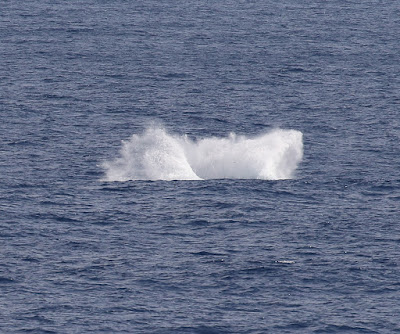Today was expected to be a big day for the Plancius & the passengers as we were due to cross the Equator. Crossing the Equator tends to be an excuse for some general frivolity on ships. We were expecting to cross the Equator around 09:15 and there were a lot more passengers on deck immediately after breakfast than normal. Many people were crammed into the bridge or were excitedly watching GPSs or their mobiles (for those connecting to the ship's satellite internet system). Given I had chosen not to connect to the wifi for the time I was at sea, I made do with scanning with my bins & noting that nothing changed: except a lot of people took photos & cheered for having crossed the Equator. As far as I could see, there were no Seabirds or Cetaceans on view on either side of the line. There were a few Seabirds seen during the day, but those that were seen were repeats in low numbers from the previous day. However, we did see the first Scopoli's subspecies of Cory's Shearwater for the Odyssey. Just before 15:00, there was an announcement that King Neptune had come onboard & everybody was invited to head down to the aft deck.
King Neptune on the aft deck: Photo taken from the Expedition trip report (with the copyright for the photo remaining with Christope Gouraud from the Expedition staff)
Those passengers, Expedition staff & crew who hadn't crossed the Equator before, got to meet King Neptune along with Mermaid Marijke, before getting covered in jelly, chocolate & strawberry sauce, before being washed down in water. Having straddled the Equator in Kenya & Ecuador, I decided that I could safely give this a miss & keep looking for Cetaceans. The timing was perfect, because no sooner had the announcement of King Neptune's arrival finished, then I picked up a couple of distant blows. A few minutes later and we could see that they were Sperm Whales. Unfortunately, they chose to dive. But it was a good sign of things to come.
One of the first two Sperm Whales of the day fluking as it prepares to dive deep: Just part of the entertainment laid on for those not wanting to meet King Neptune
Over the next two hours we encountered around thirty Sperm Whales. A number of the Sperm Whales remained distant and either fluked before we got close or passed around a half mile away from the Plancius. But finally, some performed closer to the Plancius. With most of the passengers, Expedition staff & crew distracted at the aft, then there was nobody who was going to request that we slow down for a longer encounter with one of the parties of Sperm Whales. However, as we had enjoyed a great experience with some Sperm Whales only four days earlier on the crossing between St Helena & Ascension Island, it wasn't a big deal.
Sperm Whale: This photo was taken a few seconds later & I needed to include an addition 50% of sea to get all the splash in
Sperm Whale: Another breach. Male Sperm Whales can grow to 19 metres & 57 metric tons, whereas, the largest females grow to 12 metres & 19 metric tons. I'm not sure of the sex of this individual, but it's impressive that they can emerge this far out of the water. Some of the Rorqual Whales can launch most of their bodies out of the water
Sperm Whale: One of the key identification features of Sperm Whales is their asymmetric blow hole which faces left
The final treat was seeing a fairly close female Sperm Whale with a youngster.
Sperm Whale: Female Sperm Whale with a nipper just popping out of the water
Sperm Whale: The youngster was curious & on a couple of occasions it stuck its head out of the water to see what was going on. This is called spyhopping & is probably my favourite activity to see Cetaceans doing, as I've only seen spyhopping on a few occasions
It was a good afternoon & there were more Cetaceans to come, but you will have to wait until the next Blog Post.

















 ;
;